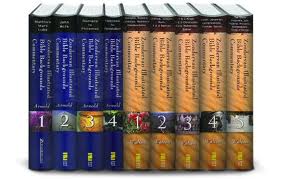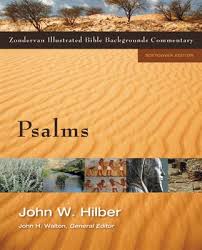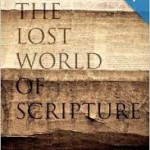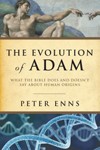 In 2009, Zondervan released the Zondervan Illustrated Bible Backgrounds Commentary. The Old Testament portion of this set is a massive 5-volume, 3000+ page, hard cover boxed set that cost about as much as my first car. (The New Testament set is a mere 4 volumes.)
In 2009, Zondervan released the Zondervan Illustrated Bible Backgrounds Commentary. The Old Testament portion of this set is a massive 5-volume, 3000+ page, hard cover boxed set that cost about as much as my first car. (The New Testament set is a mere 4 volumes.)
The dilemma is that this heavy and expensive set (about $35/volume) is also immensely helpful for giving interested readers a sense of the cultural background to the Bible. Zondervan has begun responding to this problem by breaking up these volumes and selling them as individual volumes on single books of the Bible (between $13 and $15 on Amazon).
The three volumes just released are Genesis by John H. Walton (who is also the general editor of the entire set), Isaiah
by David W. Baker, and Psalms by John W. Hilber (for which there is no Amazon link, for some reason).
I am very glad to see these volumes released in an affordable manner to make them more accessible. The great strength of this entire set is the broad sweep of cultural background information given–which includes copious photographs, maps, and charts. Readers are not shortchanged in their exposure to the Old Testament’s cultural setting. Students who need to track down issues on a deeper level will have more than enough to do by working through the learned and insightful footnotes (over 700 in Genesis and Psalms, and nearly 1800 in Isaiah). These books give you a ton of information right at your fingertips.
The limitation of these volumes is that they tend to give “standard” evangelical answers to perennial issues that do not sit easily within evangelical boundaries, and at times punt when controversy is afoot. Without wanting to diminishing my strong endorsement of these volumes, I see a tendency for some if its authors to lapse into a common evangelical “dance” with critical biblical scholarship that I find at best distracting and unhelpful.
For instance, Walton begins his Genesis volume by asserting, “Inferences drawn from the whole of the biblical text suggest that Moses was considered responsible for the shape and content of Genesis from the earliest times” (p. 5). Walton certainly knows that this assertion is hardly self-evident, and is in fact at odds with the vast majority of biblical scholarship for several hundred years. One senses some hesitation on his part in the non-commital language “was considered responsible.” Two sentences later Walton acknowledges with similar non-commital language that the authorship discussion is actually “not without significance” but then deems it of little importance for the dealing with cultural backgrounds.
On one level I understand this uncomfortable dance with critical scholarship. It is common in evangelical deliberations and perhaps even necessary for some. But I don’t see what would be lost by beginning this volume, not with a safe yet dubious declaration of mosaic authorship that is then somewhat neutralized, but with (1) a simple acknowledgment of the scholarly consensus that the composition of Genesis has a long developmental history that does not come to an end until the postexilic period, (2) Walton explaining his disagreement with that consensus, and (3) explaining why he thinks the entire authorship question is not all that central to addressing cultural backgrounds.
Perhaps it was felt that readers needed to be assured before launching into other controversial matters that for Walton are hills worth dying on. Walton’s last introductory section is on the question of mythology (pp. 9-10), where Walton suggests to his readers (though not in so many words) that Genesis is an alternate ancient Near Eastern mythology rather than a book that participates in a scientific worldview. Perhaps his statements on authorship several pages earlier are intended to create a safe space for his discussion of mythology.
Perhaps. But some might read Walton’s assertion as a “state of the discipline” observation and depart with a false sense of security, which in the end could cause more harm than good.
Similarly, Baker in the Isaiah volume comments, “The compositional history of Isaiah is debated, with numerous views as to the number of authors and the time of composition” (p. 4). Baker is a good and careful scholar, and this is certainly a true statement on one level. On the other hand, there is an important sense in which Isaianic authorship is not seriously debated, namely–like Genesis–a compositional history spanning several generations, if not centuries, with the exilic and postexilic periods playing a fundamental role in the book’s final form.
I can fully appreciate the need to say something about an issue that can’t be avoided, and to say as little as possible so as to avoid distractions for the intended reader of the volume. But readers looking for apologetic support for a fully 8th century Isaiah might find here an unwitting accomplice, as if Baker were saying, “The issue of authorship of Isaiah is completely up in the air,” which is not what Baker is saying.
I don’t mean to dwell on the negative, but these sorts of statements seem designed to deflect conservative reaction and criticism, and false impressions are created.
In closing, though, let me say that these volumes are truly rich resources that can be used with great profit by lay readers and researchers alike. I’ve taught courses on Genesis, and I always consult what Walton has to say about cultural context and my students benefit from it. When I am reading along in the Bible, and something strikes me as curious and in need of fleshing out, I reach over to the 5-volume set I own and and see what ZIBBC has to say.













